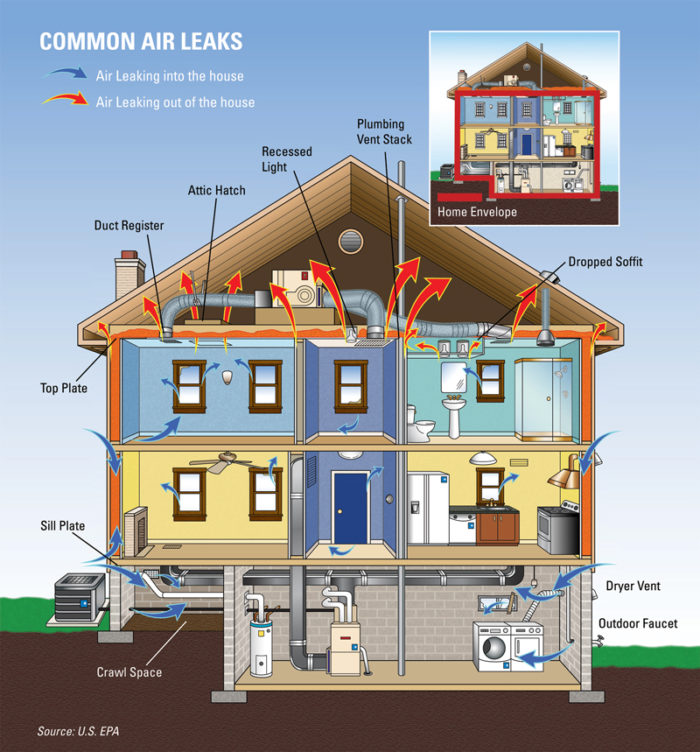
Image Credit: U.S. Environmental Protection Agency
Ask almost any building performance expert what you should do first to cut your utility bills and improve the energy efficiency of your home, and the answer will inevitably be to weatherize. And that’s as it should be. Most of our homes are rife with air leaks. According to the U.S. Department of Energy, in the average American home, 30 cents of every dollar spent on heating and cooling is lost to air leaks and insufficient insulation. That’s a lot of money to let slip — literally — through the cracks!
If you live in a drafty, underinsulated house, you should no doubt focus first on weatherization. But, as important as it is, weatherization may not be enough to ensure an environmentally and financially sustainable level of energy use. There are other increasingly important drivers of residential energy consumption that can’t be addressed by air sealing and insulating.
Our electronic gadgets use lots of electricity
Since the 1970s, the amount of energy that Americans use for heating has fallen 40%. This is largely due to improvements in the efficiency of our mechanical systems as well as tighter, better insulated buildings.
And yet overall the residential sector uses only slightly less energy today than thirty years ago (10.18 quadrillion Btus compared to 10.56). Any guesses as to why this is? Here’s a hint: just think about all the electronic devices you have in your home now that you didn’t have 30 years ago. In the space of a generation the amount of energy we use to run our home entertainment systems, refrigerators (yup, an increasing number of us have more than one), and other electronic gadgets has nearly doubled.
Now consider how much bigger the home you live in now is than the one you grew up in. It’s bigger, right? In 1950, the average U.S. home was 1,100 square feet and the average household size was 3.4 people. Flash forward to 2009: the average new home is 2,438 square feet and the average household has 2.6 people. In just two generations, home size has increased by 120% and average household occupancy has dropped by 24%. Square footage per household member has tripled from 324 to 938 square feet. Not to mention that we keep on building new homes.
Smaller homes and fewer gadgets
Efficiency gains are just barely keeping pace with increases in consumption. Which means that for most homeowners, air sealing and insulation are simply not enough to keep energy costs in check over the long term.
We also need to pay much closer attention to plug loads, making sure that our electronics and appliances are as efficient as they can be, and asking ourselves hard questions about what we really need. Do we really need that second refrigerator? Two game systems? Fifteen recessed lights in our kitchen? When building or renovating, this would include asking hard questions about home size as well. Do we need a formal living and an informal family room? An eat-in-kitchen and a formal dining room?
Of course conservation on its own is not a realistic strategy for improving home energy performance. But, then again, neither is weatherization.
Rachel White is performance manager at Byggmeister, a high performance remodeling firm based in Newton, Massachusetts, on a mission (impossible?) to quantify the impact of its work.
Weekly Newsletter
Get building science and energy efficiency advice, plus special offers, in your inbox.














2 Comments
Quads per capita
If you factor in population growth over that time (~230 million -> 314 million), that's actually somewhat impressive; that's almost a 30% drop per capita if I did my math right. But population growth thwarts us as well.
kill-a-watt meter and other methods
I do energy audits periodically using a kill-a-watt meter ( and an earlier version by brand electronics)
Small thing help.. like putting the video cabinet on a power switch, so that you don't have phantom loads when you are not using it.
Bug things also help.. like not having a clothes dryer.. The sun works just fine in the summer, and the wood stove does equally well in the winter
And then there is solar power.. having 4.6 kW on the roof generates about 6 MWH, of which I'm only using about 3 MWH (roughly 250 kwh/month)
Log in or create an account to post a comment.
Sign up Log in